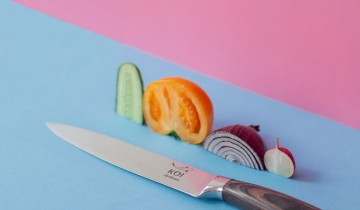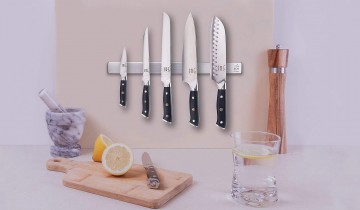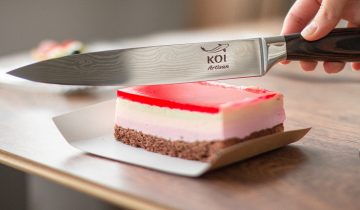As the popularity of Santoku knife grows globally, particularly in the Western world, it’s becoming increasingly vital to understand how to wield this Japanese version of a Western chef’s knife.
Santoku knives are often high-quality blades that many people consider an investment, and their versatility is frequently misunderstood. The versatility of this knife is totally determined by how and what you cut with it.
A KOI Artisan Santoku knife is a multi-purpose knife that is best used for chopping, slicing, dicing, and mincing. Its name comes from the Japanese word “santoku,” which means “three virtues” or “three purposes.” Because of the knife’s versatility, it’s ideal for chopping or slicing vegetables, cutting or mincing meat, and slicing fine seafood cuts. The Santoku is also known as the Japanese equivalent of a chef’s knife in the United States.
While a Santoku knife is a general-purpose knife that can be used for a number of tasks, it’s crucial to understand where this knife excels and where it struggles, because general-purpose doesn’t imply it can do everything!
WHAT IS A SANTOKU KNIFE BEST USED FOR?
Santoku knives are one of the most popular knives in both Japanese and Western households; they are built for precision cutting, and their ability to create ultra-fine cuts on a range of food kinds is of critical importance.

As previously stated, Santoku bōchō can be translated to mean “three virtues” or (for Western users) “three uses or three purposes” as a result of the knife’s design being optimised for mincing, dicing, and slicing or for the type of food that it is commonly used with such as meat, fish, and vegetables.
This knife’s versatility is one of the reasons it’s a kitchen staple in Japanese households, and it comes with a slew of benefits when used correctly.
What Are the Advantages of Using a Santoku Knife?
The fundamental benefit of using a Santoku knife is the precision and fineness with which it can cut. Knives made in Japan have a sharper edge than knives made elsewhere, and this is true for both double and single bevel designs.
A KOI Artisan Santoku knife’s sharper edge not only allows for a more exact and finer cut, but it also helps to preserve the flavour of the food, which is an important component of traditional Japanese cuisine and dishes.
A Santoku knife may neatly pass through the food’s cell membrane by holding a sharper edge, and without getting too technical or scientific, this clean pass retains the food’s cell integrity for a more enhanced flavour.
When fluid or portions of the food are left on the chopping board or knife after a cut, you know the knife isn’t cutting through the food cleanly (as a result of holding a dull edge). When chopping fruit and vegetables, a sharp Santoku will leave less juice on the chopping board, which is important.
A Santoku knife’s design is likewise tailored for professional usage, and you’ll discover that it’s lightweight and has a balanced weight distribution, allowing for effortless movement and long periods of use without tiring the user.

Because of the shorter blade, it is also easier to control, which is one of the reasons why this knife has become so popular in many households. Many Western cooks prefer to use the smaller and simpler to wield Santoku since a Western chef’s knife can range in size from 8″ to 12″, which is notably larger than the ordinary 5″ – 8″ Santoku.
How to Use a Santoku Knife
A Santoku knife should be used in a backwards and forwards, downward chopping action, and the knife will leave contact with the chopping board between each cut due to a flatter blade with a minimal curve. This differs from the rock chopping motion utilised with a western chef’s knife, in which the blade stays in contact with the chopping board at all times.
This cutting technique is used not just to achieve a finer cut, but also to allow the user to work more quickly.
A Santoku knife is not well-suited to heavy-duty use due to its shorter and thinner blade, and will not be able to cut through dense bone or cartilage on meat or huge fish. It will also struggle to cut through larger fruits like melon.
WHAT TYPE OF FOODS WOULD YOU USE A SANTOKU KNIFE FOR?
Santoku knives are a type of multi-purpose knife that can be used for cutting, slicing, and chopping. As a result, you may use a Santoku knife to prepare a wide range of foods, including:
Preparing the vegetables: Santoku knives are ideal for slicing and chopping vegetables, as well as making artistic cuts for dish presentation, due to their ability to make fine cuts.
Meat: A Santoku is commonly used for slicing and rough cuts on meat; however, due to the shorter and thinner blade, this knife is not well adapted to cutting dense meat with tough cartilage and bone.

Santoku knives are undoubtedly the most often used knife for slicing and cutting seafood (particularly raw fish).
Santoku knives are frequently used to make sushi dishes as a result of some of these items overlapping for a variety of cuisines.
The ultra-fine slices that a KOI Artisan Santoku knife can make on vegetables and raw seafood are appropriate for the dish presentation and flavour retention that is necessary with sushi.
Because a sushi knife set may be fairly costly, many homes will opt for the more multipurpose Santoku as an alternative.
WHAT IS THE DIFFERENCE BETWEEN A CHEFS’ KNIFE AND A SANTOKU KNIFE?
While there are some similarities between a Santoku and a Western chef’s knife, they are fundamentally separate knives with different purposes.
Here are a few important distinctions that determine how these knives are often used:
Dimensions and Weight
Santoku knives are typically shorter, thinner, and lighter than Western chef’s knives, making them easier to maneuver but limiting the quantity and density of foods with which they may operate.
When compared to a Western chef’s knife, which can range in size from 8″ -14″ (with 10″ – 12″ being the most regularly used), a Santoku knife can range in size from 5″ – 8″, which is on the smaller side when it comes to an all-purpose knife.
Blade Design
Because of the modest curvature from the heel to the tip of the blade, a Western chef’s knife has a more obvious blade shape, allowing the user to adopt a rocking motion and perform the pinch grip cutting technique.
Santoku knives have a significantly flatter edge with curvature from the spine to the tip, which is designed as a safety feature to prevent rookie users from cutting themselves.

A chef’s knife is usually constructed of stainless steel, which is tougher, easier to clean, and more corrosion resistant, but it doesn’t maintain its edge as well as other materials and hence requires more frequent sharpening. A Santoku knife can be constructed from a variety of materials, the most popular of which is a high-quality carbon-steel combination.
This allows the knife to be thinner, lighter, and have a sharper edge for longer periods of time (requiring less maintenance), while it does have certain disadvantages, such as being more susceptible to chipping and rust if not properly maintained.
Bevel
While most western knives have a double bevel, a Santoku knife is unique in that it may be made with either a double bevel (because to its rising popularity in Western civilization) or a single bevel edge, which produces a significantly sharper knife.
A Granton edge on a Santoku knife allows the blade to travel more freely between foods without clinging to the knife, resulting in a cleaner and more precise cut.
A Santoku knife is one of the most versatile and widely used kitchen knives in the world (giving a Western chef’s knife a run for its money). Its general function makes it ideal for mincing, slicing, and dicing, and the accuracy and control allow it to be used on a wide range of foods, including meat, seafood, fruit, and vegetables.

While this knife is extremely flexible, it’s important to remember that it has limitations and cannot be used for anything in the kitchen! Because of the shorter and thinner blade, it’s not suitable for larger and denser foods (such as certain meats and fruits), and many experienced cooks prefer a blade that’s between 10″ and 12″ long for greater versatility.



 No products in the cart.
No products in the cart.